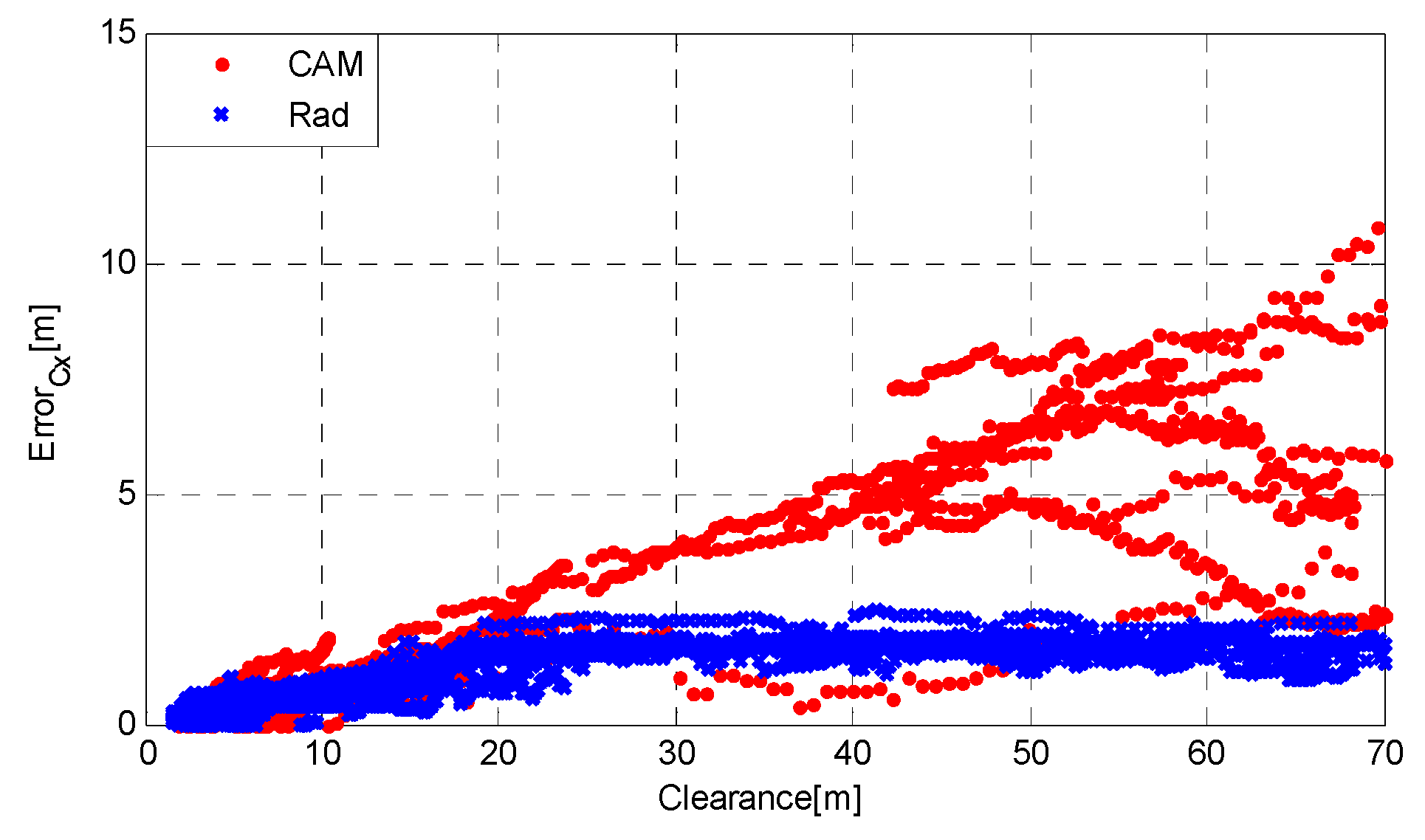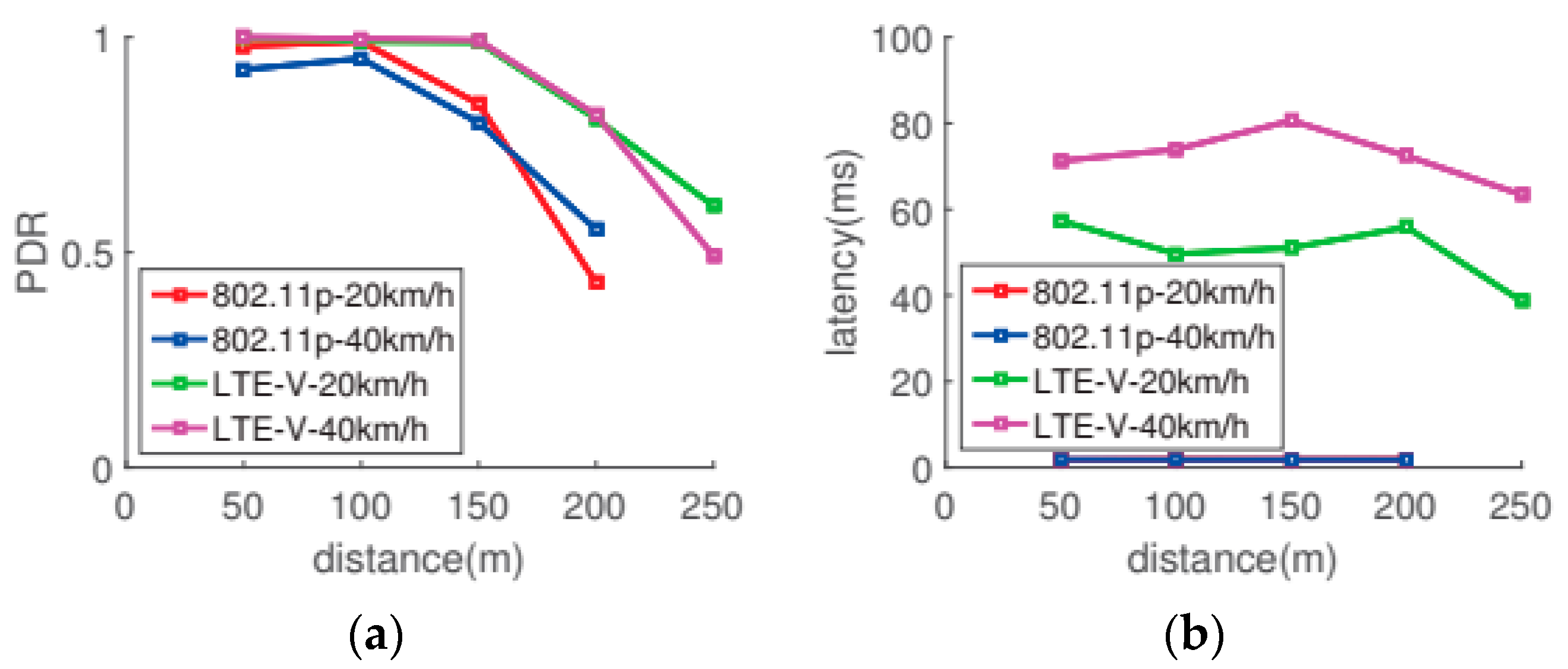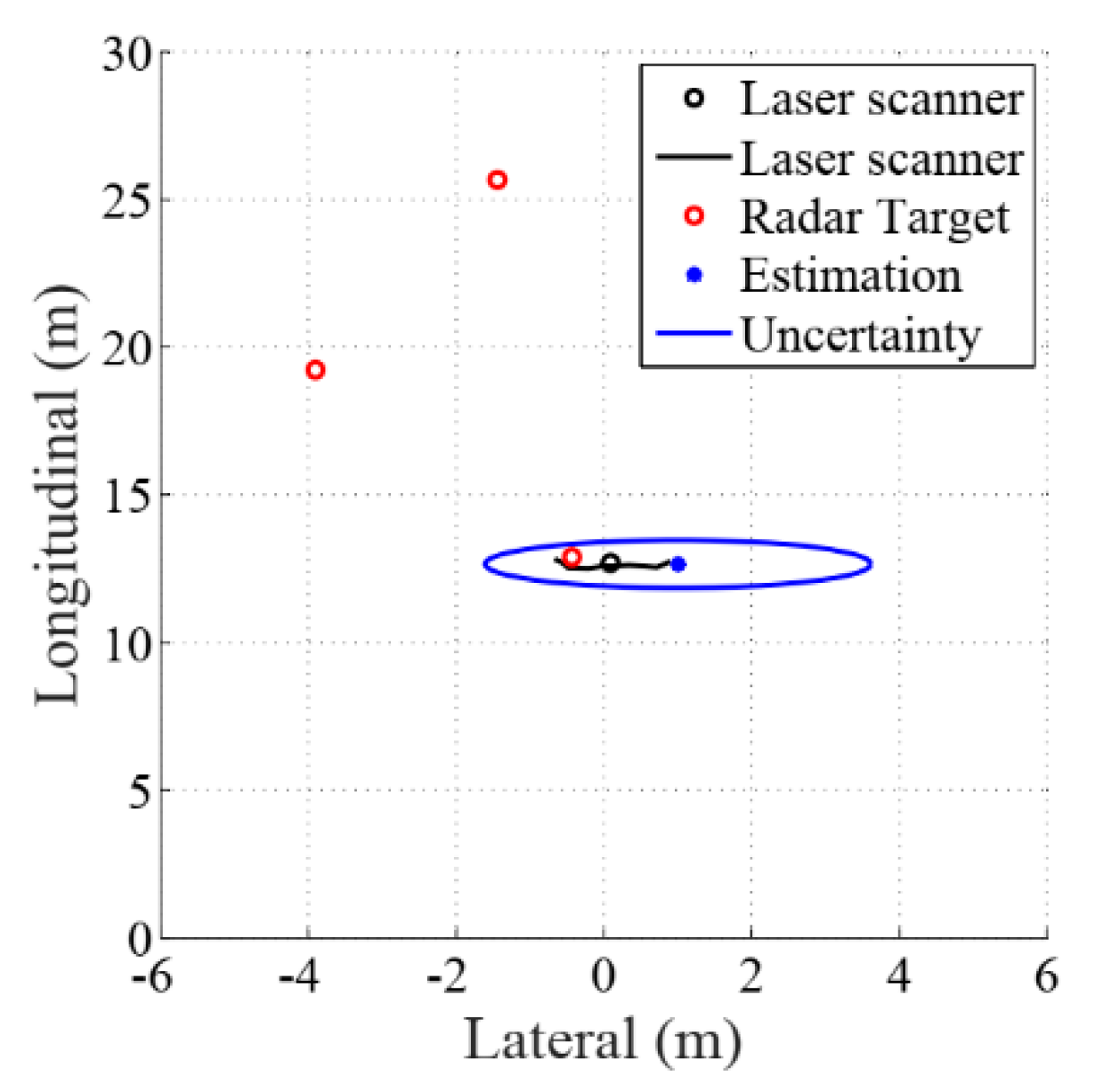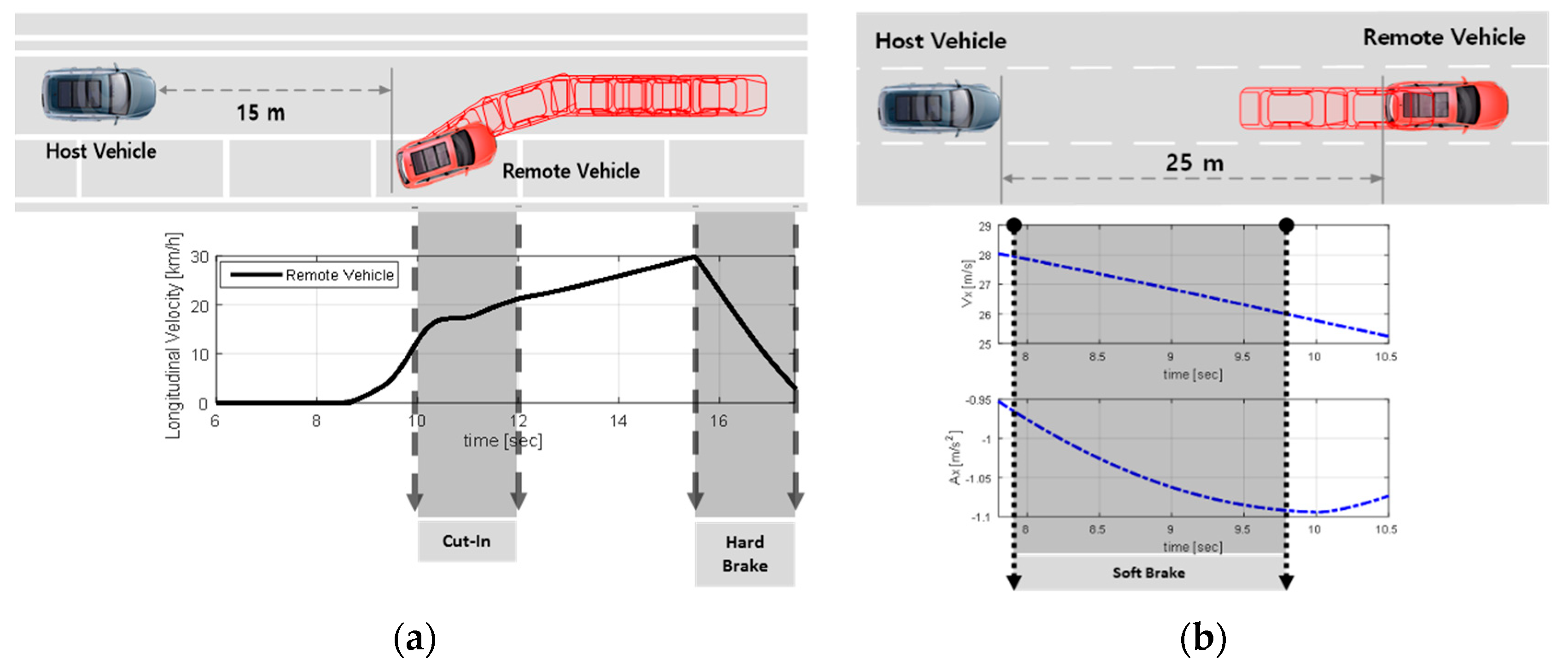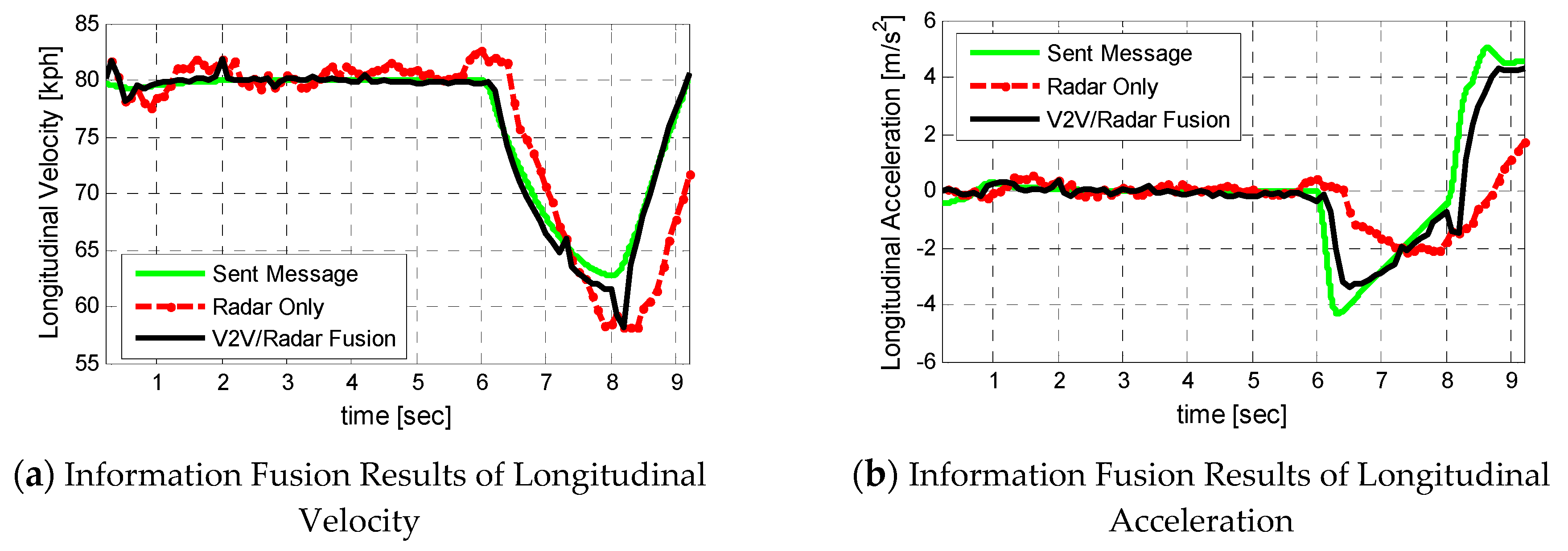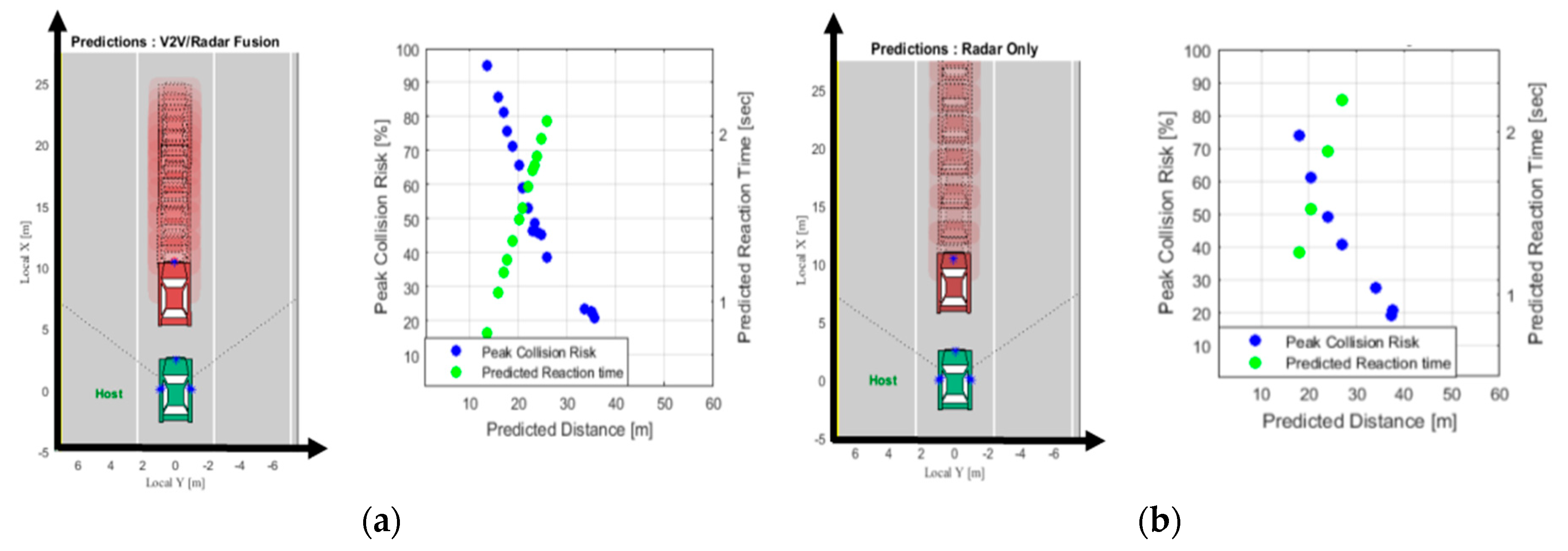The characteristics for vehicular communication and conventional local sensor systems are described. The backgrounds for radar and its sensing characteristics for application to intelligent vehicle are demonstrated. For a longitudinal safety, automotive radar is known to be the best fitted vehicular surround sensing technology with respect to functionality, robustness, reliability, dependence on weather conditions etc. [
11]. Its performance has been evaluated by comparing with the camera (vision sensor). However, due to the inherent uncertainty of the traffic environments and incomplete knowledge because of sensor limitations, V2V communication has been widely considered to provide the host vehicle with more enriched target information by fusing with the radar sensor. In this section, the advantages of radar sensor have been presented by experimentally comparing with the camera. The V2V communication information is explained as well and the comparison results of the DSRC with long-term evolution-vehicle (LTE-V) technologies are provided. In addition, a high-level data fusion architecture of radar and V2V communication is described.
2.1. On-board Ranging Sensors
The radar is currently the most widely adopted sensing technology for automotive ranging applications. The radio detection and ranging (RADAR) is a system that uses electromagnetic waves to identify the range, direction, or speed of both moving and fixed objects such as aircraft, ships, motor vehicles, weather formations, and terrain. In this technology, the distance from the object is calculated through the echoes that are sent back from the object. The determination of the position of an object is done through the time-of-flight and angle measurement. In process of time-of-flight measurements, electromagnetic energy is sent toward objects and the returning echoes are observed. The measured time difference and the speed of the signal allow calculating the distance to the object. The Speed measurement is made through the Doppler effect. The base of the Doppler effect is change of wavelength due to the changing gap between waves. Although the amount of signal returned is tiny, radio signals can easily be detected and amplified. RADAR sensors are also known to have sufficient robustness to function reliably under harsh environmental conditions for extended periods of time [
12].
Vision sensor systems use one or several cameras together with a microprocessor to perform image processing. Since they operate in the visible light region, their capabilities are similar to that of our own eyes. A camera-based sensor is used to detect car/obstacle in front of the subject vehicle. Camera-based longitudinal safety systems are typically used for medium range, medium field of view detection. The camera system can be charge coupled device (CCD)-based or Complementary Metal Oxide Semiconductor (CMOS)-based [
13].
In their basic single camera configuration, video imagers struggle to provide ranging information. However, using the principle of triangulation coupled to obstacle recognition routines, the images viewed by camera systems may be processed to facilitate identification of obstacles and their range. Such systems provide good obstacle and environmental recognition using non-intrusive means.
Cameras are able to provide information about target position for slow moving vehicles. They are capable of detecting targets even when placed at a distance from the region to be monitored. However, cameras placed in this fashion provide poor longitudinal position accuracy.
An experiment was performed by using the test vehicle which is equipped with radar and vision sensor systems for measuring the range and range-rate to the proceeding vehicle under vehicle following situation in order to evaluate longitudinal safety. Data acquisition is performed at various ranges and relative velocities with constant speed of the target vehicle. In many cases, due to road curvatures, other vehicles, uneven road surfaces relative lateral position and lateral movement, the measurement range distribution might be different. Also, the exact reflection point is uncertain since the azimuth angle is not very exact, so for medium distances the main reflection point may be located on different parts of the car. Hence, test data was collected in the test road without other vehicle or obstacle.
The lateral displacement of the longitudinal centerline of the subject vehicle relative to the longitudinal centerline of the target vehicle kept less than 0 m. The subject vehicle cruises behind the preceding vehicles in initial vehicle speed. The initial speed and range of subject vehicle (SV) and preceding vehicle (PV) are set to be
Table 1. To validate the sensor detection performance, the GPS-based device, RT-Range, is used to measure the reference of the range and range rate data. The RT-Range device uses RT-3000 which is precision GPS device, and is equipped on the test vehicle respectively.
In
Figure 1, range error in vehicle test is depicted. As shown in
Figure 1, vision sensor and radar sensor have similar detection error pattern within the 10 m range. On the other hand, range error in vehicle test is depicted. As shown in
Figure 1, vision sensor and radar sensor have similar detection error pattern within the 10 m range. On the other hand, range error of the vision sensor is bigger than the radar sensors over the 10 m range situation. In terms of range and speed measurement for application to vehicle longitudinal safety, radar data demonstrate more accurate results compared to camera.
2.2. Vehicular Communication
Connected vehicle technologies evolved from the 1980s with the widely known project called the California Partners for Advanced Transit and Highways (PATH) project. Multi vehicles made by Ford Motor Company are platooned together with the longitudinal control using wireless LAN communication systems as well as radar, throttle, brake actuators. In 1992, the it was remembered that the first ever platooning experiments and demonstrations on the highway were performed successfully.
Volvo demonstrated vehicular wireless communication technology for the project named Safe Road Trains for the Environment (SARTRE) in 2012. In this demonstration, a Volvo FH truck drove around the test track, followed by other Volvo cars with quite close inter-distance. Although the inter-distance between the vehicles was smaller than when a human drives, it is much safer since the computer responds to even trivial or small change is detected. For the demonstration, V2V communication with 802.11 p is used for the main communication channel.
In 2013, Hyundai Mobis and Seoul National University demonstrated V2X communication enabled autonomous driving technologies in Korea, at the ITS test site in Hwaseong. Two Hyundai Sonatas from Mobis and one Hyudai Azera are used to perform several scenarios with Cohda MK5 wireless communication device. The scenarios include Intersection Management Assist (IMA), Electronic Emergency Brake Light and Blind Spot Warning.
Dedicated Short Range Communications (DSRC) is one of the researching hotspots, and it has already the become V2X communication standard in some areas, such as America and the Europe. Meanwhile, the performance of DSRC in non Line-of-Sight scenarios is quite terrible and the performance declines rapidly when the number of vehicles increases to some threshold. These shortcomings of DSRC are widely admitted by researchers. Thus, LTE-V is one of the Cellular Vehicle-to-Everything (C-V2X) direct communication technologies, and which might take place of DSRC.
To validate the performance of LTE-V, Shi et al. [
14] conducted an experiment with two cars at an intersection. During the experiment, messages were sent 10 Hz and two conclusions are derived: PDR (Package Deliver Rate) and latency, which are shown in
Figure 2.
Since safety related applications for V2V communication are susceptible to even a bit longer latencies, this could cause fatal accidents when an emergency braking situation. To guarantee traffic safety, when a control command, braking for example, is sent to a car, the car must receive the command within 1 ms.
The latency of a 4th Generation (4G) network, which is a sort of LTE-V, cannot meet this requirement. With the latency of a 4G network, a car driving at 100 km/h still moves 1.4 m from the time it finds an obstacle to the time when the braking command is executed. Under the same condition, with the latency on a 5G network, the car will move just 2.8 cm, and this performance is comparable with the standard of an anti-lock braking system (ABS) [
15].
A 5G-based C-V2X communication is introduced by Huawei, LG and Qualcomm. Since 5G-enabled communication has ultra-low latency of 1 ms with the average communication speeds of 3.6G bit/s using 100 MHz bandwidth, safety related vehicle control applications can be considered. As the size of the data are getting bigger, infrastructure-based remote computing is needed and the 5G communication is applicable for the transmission and receipt of big data. Infrastructure-based computation means using a cloud or edge computing. Two computing methods have their own advantages and disadvantages. Cloud computing has no limitation of computing power; however, it has more likely to experience slow internet connection issues. Edge computing is much faster than cloud computing; however, the computational resource is limited or is hard to expand.
Korea Telecom (KT), one of the cellular communication providers in Korea, demonstrated Level 3 autonomous driving technology with 5G communication. Two buses were demonstrated with the 5G connected technology by exchanging their driving information as well as video that shows blinded front traffic situation. This connected technology-based service is promising for the future connected automated driving since it can stabilize Internet-based service which is going to be applied for the safety related functions for the intelligent vehicle. Connected automated driving technology needs to offer less than 10 ms of latencies with less than 1% of packet error rate. This allows the autonomous vehicle to drive safely without any issue of communication error.
In the future, the C-V2X solution and the convention ADAS local sensors are to be combined for 100% of guaranteed safety. Even though we use the edge computing with 5G communication, there are still chances for communication errors. This still makes us use local sensor-based safety functions in terms of emergency situations such as emergency driving situations. For normal driving situations, infrastructure computing (cloud or edge) based-based autonomous driving can be performed cooperation with other surround vehicles. This allows the vehicles to drive much safer and much smoother.
2.3. Information Fusion of Radar and V2V Communication
The V2V communication, however, has several limitations when it applies to automated driving. GPS receiver has poor position estimation performance when it enters a tunnel or urban shadowing area due to low signal strength and multipath propagation error.
These situations cause degradation of target tracking performance which bring about dead-reckoning mode, and consequently producing larger errors. Depending on the transmission power and receiver sensitivity, transmission messages can be received up to a distance of 1 km [
16]. However, obstacles, such as buildings in urban environments, the surrounding topography in rural environments or big trucks on highways might block the wireless signal and thus make a communication between vehicles not possible. ITS-G5 (European standard for V2V communication) uses Carrier Sense Multiple Access with Collision Avoidance (CSMA-CA) to access the wireless channel and avoid the occurrence of packet collisions. However, in dense traffic scenarios, packet collisions occur and can lead to a drop in performance of a cooperative positioning approach [
17]. Therefore information from V2V communication is often considered not to be reliable enough to initiate automated maneuvers.
On the other hand, radar (camera and LiDAR systems as well) has its own limitations. Many heuristics are applied to the object detection, which leads to a compromise between sensitivity and false positive rates. Static objects or objects in far distances are very hard to detect reliably. Despite the shortcomings in both technologies, we found they are complimentary to each other.
Radar can provide a constant passive scanning of the surrounding, catch all detection candidates and provides good relative positioning measurements. If those candidates happen to be V2V communication device equipped, the information from their DSRC messages can help to eliminate almost all uncertainties and enrich those candidates with much more additional information. In this way, we do not need to worry about the drops in V2V communication message reception and low quality of positioning from GPS.
In
Figure 3, in the high level fusion architecture, all sensor information is processed at the sensor level, making possible applications which have high standard modularity and simplicity. Therefore the high level fusion is proposed and it has been successfully and well described in automotive applications, such as adaptive cruise control [
18] and for other active safety feature [
19].
The demonstrated high level fusion architecture for the automated driving algorithm is composed of two. One is a local filter and the other is master filter as seen in
Figure 3.
For the radar data process, at a local filter, extended Kalman filters (EKF)-based interacting multiple model (IMM) has been implemented to compute the remote vehicles’ dynamic states with relative position and velocity. A state augmented estimation algorithm to compensate the communication latencies is used in the V2V communication local filter. To express dynamic motion of the remote vehicle, we derive a kinematic vehicle model. After then, to describe the remote vehicle’s CAN bus, standard measurement model is derived and the vehicle information is transmitted. The state vector of the local filter of V2V communication is derived in (1):
Here subscript is remote vehicle, is the relative position between two vehicles, is the relative yaw angle between two, is the longitudinal speed, is the yaw speed, is the longitudinal speed, and is the derivative term of yaw speed.
In
Figure 3., fusion of V2V communication track and radar track is described in the master filter. To perform a track-to-track association for the data coming from two independent sources in local filter,
and
, the first step is to regard how close one track is to another so that association decisions can be made. A validation region is the volume in state space where tracks are expected. This validation region is usually expressed in terms of the Mahalanobis distance.
For example,
Figure 4 shows an example of a radar measurement validation. The reference (true) position of the target-vehicle is shown in black line which is target vehicle trajectory. A V2V/Radar fusion result is expressed by blue dot, which is a current estimated target-vehicle location. The estimation uncertainty is shown to be a three sigma ellipse in red. The red circles are radar measurements, of which only the nearest to the current estimate are used to update the baseline. The advantage of using a validation area based on the Mahalanobis distance instead of an Euclidean distance is that it takes the uncertainty in each of state variables with different units, into account.
Given two tracks, radar and V2V with mean estimates and covariances represented by
and
, the Mahalanobis distance is defined as:
Both the uncertainty of the state estimate and that of the measurement influence the Mahalanobis distance. The smaller these uncertainties are, the higher the associated distance. For the experimental sections, the Mahalanobis distance threshold was empirically set to 5, in order to get a good rejection of outlier radar measurements, due to other vehicles and scatter the state estimate and that of the measurement influence the Mahalanobis distance. The smaller these uncertainties are, the higher the associated distance. For the experimental sections, the Mahalanobis distance threshold was empirically set to 5, in order to get a good rejection of outlier radar measurements, due to other vehicles and scatter. Data association techniques are used for relating measurements to targets [
20]. Unlike the Nearest-Neighbor approach, where only the measurement which has the smallest Mahalanobis distance to the target is used to update the measurement; in probabilistic data association all measurements in the validation region are taken into account.
